Executive Summary
First proposed in 1955 by Milton Friedman, an Income Share Agreement (ISA) is an alternative to traditional loans for students when funding their college educations. Instead of borrowing money, the student enters into an agreement with their school (or some other institution) whereby the student agrees to pay a percentage of their future earnings for a certain period of time. In other words, the student is effectively funding their education using equity (in themselves), rather than debt.
The upside of ISAs, at least in theory, is that as with other types of equity (vs debt) financing, the student can ensure that the payments to finance their education remain a reasonably manageable percentage of their income and avoid getting to a point where they can’t afford to pay their monthly student loan payments. The caveat, however, is that Federal student loans already have income-sensitive features to protect from student loan payments becoming unduly burdensome, and as it turns out Federal student loan programs are actually more favorable over ISAs for low-income students. Which means that, depending on the student’s specific circumstances, answering the equity over debt question may not be as simple as it seems.
In this post, Derek Tharp – lead researcher at Kitces.com, and an assistant professor of finance at the University of Southern Maine – examines Income Share Agreements, and delves into the question of how they compare to, and when they might be a better option, over a more traditional loan for students looking to finance college.
As a starting point for comparing the two options, we can calculate the difference in the net present values of cash flows resulting from utilizing an ISA versus taking out a student loan, with the important caveat that an income share agreement will have different rates and terms depending on a student’s major due to the variety of job outlook and projected earnings in different industries. So, for instance, an English major, whose rates and terms are on the less favorable end of the ISA spectrum, will receive different terms than an Aerospace Engineering major, which is on the most favorable end of the ISA spectrum.
Using some assumptions based on the ISA offered by the Purdue Research Foundation (a leading innovator in this new type of financing), hypothetical cash flow projections suggest that students will generally come out ahead when using a federal loan compared to an ISA. However, the case is less clear when comparing ISAs to private loans. Since private loans do not have some of the same income-sensitive features as Federal loans, ISAs can provide some downside protection, but can also do so at a significant cost assuming that a student eventually earns an income roughly average or above within their field.
The caveat, however, is that ISAs do provide a significant opportunity to engage in adverse selection (a problem which ISA providers must solve if these arrangements will be viable in the long-run)., Whenever students possess private information about themselves and their future career desires that a counterpart cannot possibly know (e.g., a desire to become a stay-at-home parent shortly after graduation or a desire to work in a field with substantially lower pay than is normal for a graduate with their degree… and thus don’t anticipate having any income which can be “shared” back to the lender), ISAs look relatively more attractive. Additionally, depending on how “income” is defined in an ISA (which appears to only be W-2 and Schedule C income in the Purdue agreement), ISAs may look attractive for students working in nontraditional fields or who can structure their income as something that does not meet an ISA definition of income (e.g., “passive” rental income is not treated as Earned Income for ISA repayment purposes).
The key point, though, is simply that although “equity financing” college with an ISA may seem to intuitively be a favorable alternative to student loans, the advantages don’t pan out when we start looking at the total costs and the impact they have on future cash flows. And while ISAs may provide some significant downside protection when compared to private loans, that protection comes at a material long-term cost if the student earns at least an average income in their field of choice. In other words, the answer to the question of when it would be better to finance a college education with “equity” in a student’s future earnings is a resounding: rarely. Instead, most of the time it’s better to simply engage in fixed-debt financing to fund a student’s long-term upside career potential!
What Is An Income Share Agreement?
An Income Share Agreement (ISA) is a contract that a student enters into with their school (or some other institution) that obligates the student to hand over a certain percentage of their future income in exchange for dollars to put towards their education today. Effectively, it is akin to offering equity in oneself (i.e., a share of the individual’s future earnings), in contrast to traditional debt financing of higher education via student loans.
Some proponents argue that income share arrangements are superior to student debt financing, as the future liability is fixed a percentage of income, and therefore will automatically be adjusted upwards – or perhaps more importantly, downwards if necessary – according to a student’s actual financial outcomes. In other words, by agreeing to pay a fixed percentage of one’s income, students can ensure that their student financing obligations will never exceed some pre-defined (percentage) threshold of their total income in the future.
To illustrate, assume John’s university agrees to provide some funding in exchange for 5% of his future income for 10 years. With a traditional loan (e.g., a private student loan), John may owe up to 100% of his income or more if his income is low enough. But with an ISA, he can rest assured that he will never owe more than 5% of his income. So, in the event that he struggles to find a job after graduation and is underemployed earning $25,000 per year, John can at least know that he’s only going to need to repay $1,250 in his first year after graduation (and that year will count as a full year’s worth of his repayments, meaning John is 1/10th of the way towards paying off his education after repaying only $1,250).
As a result, ISAs, at least in theory, reduce the potential risk to John of being overly burdened by the cost of financing his education. However, the reality is that not all student loans are structured as a “traditional” loan. In particular, Federal student loans already have similar income-sensitive components built in. In fact, many of the features of student loans to protect lower-income individuals are more favorable to students than the terms associated with ISAs!
Nonetheless, ISAs do have some unique properties which could be useful when used in the right circumstances… all of which raises the question: when would it be better to use student loans (and finance education with debt), and when might it actually be better to use the new ISA structure (and finance education with ‘equity’ in the student’s future earnings) instead?
Income Share Agreements vs. Federal Student Loans
Income Share Agreements
Conceptually, income share agreements (ISAs) have a long history. In a 1955 essay titled The Role of Government in Education, Milton Friedman proposed that “buying shares” in individuals as a means to finance higher education could be a beneficial arrangement. Yale not-so-successfully experimented with ISAs in the ‘70s, and, more recently, states, universities, and private lenders have all been exploring ways in which ISAs can be used to help finance higher education.
One key way in which many ISAs differ from Federal student loans is that students may be charged different rates (i.e., different percentages of future income in exchange for the same amount of dollars) based on various factors, including the field in which they are studying. So, for example, two students at Purdue University (which, via the Purdue Research Foundation, has been one of the pioneers in developing modern ISAs), both expecting to graduate in December of 2019, might pay the following rates in exchange for $1,000 to put towards tuition:
- English Major: 0.45% of their future income for 116 months
- Aerospace Engineer: 0.27% of their future income for 92 months
These rates and duration of payments vary due to the fact that English majors and aerospace engineers have differing incomes at graduation, differing likelihoods of being unemployed or underemployed, differing future earnings trajectories, etc. According to Purdue’s ISA comparison tool, an English major may expect to earn about $31,000 upon graduation, whereas an aerospace engineer may expect to earn about $62,000. Not surprisingly, aerospace engineers can, therefore, receive ISA rates close to ½ of what English majors have to pay (as it still nets roughly the same amount to the lender offering the ISA).
The chart below provides a sense of how much various majors would pay under an ISA, by field of study (based on Pursue’s ISA program). In each case, the rates and terms of future income sharing required to fund $1,000 in expenses are provided:
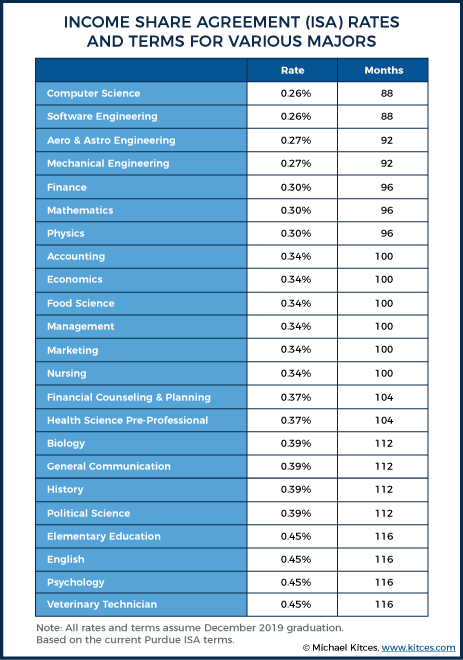
As the chart above indicates, hard sciences and the more quantitative applied fields are able to finance their education at the lowest income share rates, whereas the humanities and other lower-paying fields must “share” a greater proportion of their income.
(Interestingly, “Financial Counseling and Planning” comes in near the middle of the considered majors. Because financial planning and financial counseling are both fairly different in terms of their expected earning trajectories after graduation, this could be an example of a case where this averaged rate is more attractive for aspiring financial counselors, and less attractive for aspiring financial planners.)
As students progress through their academic careers, any ISA obligations will stack upon each other. Furthermore, rates will often vary based on the year funding is taken out. So, for example, a sophomore aerospace engineer at Purdue (ISA funding at Purdue is not available to freshman), may actually need to pay 0.40% to borrow $1,000, whereas juniors and seniors may owe 0.30% and 0.27%, respectively (all values at 92 months of repayment). If we assume that a student needed to borrow $10k per year for their final three years of their education, they would owe a total of 9.7% of their income upon graduation (0.4*10+0.3*10+0.27*10). Funders may generally specify a maximum amount of one’s future income that can be obligated towards any ISAs; under the Purdue agreement, the cap is 15% under the Purdue agreement.
Notably, most programs also have a “payment cap,” typically up to 2.5x of the initial amount paid towards one’s education (Purdue happens to cap payments right at 2.5x the amount paid towards one’s education). This cap is important as a means to place a reasonable limit on how much someone would need to pay in the event that they do end up earning a lot after graduation, and also to try and avoid discouraging participation in the first place from those who feel they may be higher income earners in the future.
For instance, caps help to ensure that if the aerospace engineer in the example above ended up owing 10% of their income after taking out various ISAs throughout their education, they wouldn’t actually be stuck with a $10 million repayment obligation in the event that they made $100 million as part of a successful startup. Instead, they could buy themselves out of the ISA by paying the difference between 2.5x the amount dispersed to them (plus fees) to pay tuition in the first place, and any income sharing payments they had already made.
For example, if John borrowed a total of $10k in the last year of his education and needed to buy himself out during his first year of repayment, he would need to pay back a total of $25,000, and paying $15k in interest on a loan of $25k is roughly akin to paying an annual interest rate of 150%!
As the above example shows, needing to buy out an ISA still ends up being expensive financing. In fact, assuming an ISA was taken out in one’s last year of studies, such 2.5x buyouts could be akin to an effective annual interest rate ranging anywhere from 9.6% to 150%, depending on when the buyout occurred – but this may be a potential upper bound cost that is tolerable (after all, it only applies when the individual themselves is having significant career upside as well), given the downside protection that it provides.
Common Terms And Provisions Of Income Share Agreements
While ISAs can vary substantially from one provider to the next, looking at some of the specific terms within Purdue’s ISA can help to give a general understanding of how ISAs might address some common questions that come to mind.
For instance, can individuals just sign up for an ISA in hopes of never working and never repaying anything? No, or at least not over the initially defined term. Individuals cannot get out of their ISA obligation simply by relaxing and taking time out of the workforce. Various deferment triggers exist which may extend one’s payment. Within Purdue’s agreement, one’s clock does not start until after an initial six-month deferment period after graduation (or dropping below half-time enrollment). After this initial deferment period, individuals have to be either employed full-time (an average of 35 hours or more), employed part-time and earning more than $20k per year, or unemployed and actively seeking employment in order for their clock to keep ticking.
Those who take time off out of the workforce (e.g., to care for a child, illness, etc.) do not have to make any payments, but their term is extended as well. However, Purdue’s ISA does appear to suggest that the maximum term of extension is 60 months, which would seem to imply that similarly structured ISAs could become very attractive for individuals who wish to (or plan to) spend significant time out of the workforce raising children (although, one would think that ISA providers must find a way to address this longer-term, or adverse selection will make them financially unviable?).
Notably, Purdue’s ISA does eliminate all monthly payment obligations for anyone working full-time and earning less than $20k, while still allowing them to accumulate credit for those months towards fulfilling their ISA. When combined with crediting time towards those who are unemployed but actively seeking employment, agreements structured similar to the Purdue ISA do provide a nice cushion in the event that someone genuinely falls on hard times.
Notably, under the Purdue ISA, $20k is a hard breakpoint (i.e., there’s no graduation or pro-rating of payments on either side of $20k income), which can create some perverse incentives. So, if a student has participated in ISAs up to the point of owing 15% of their income after graduation (the maximum Purdue ISAs permit), the student would owe $0 if their income was $19,999, but $3,000 if their income is $20,000. This effectively creates an incredibly high marginal tax rate for some low-income individuals and is yet another example of the “poverty traps” that can unintentionally result in marginal tax rates of 80% or higher for low-income individuals.
Although Purdue’s definition of “earned income” in their ISA appears to be dated (presumably their reference to summing Lines 7 and 12 and one’s Form 1040 refers to the 2017 version of Form 1040 before it was revised for 2018), the income they are interested in appears to only be W-2 wages and Schedule C income of the individual who signed the ISA agreement (i.e., spouse’s wages don’t count, nor do capital gains or pass-through or other passive business income reported on Schedule E).
(Note: While it may not be feasible for many individuals who don’t have some other form of financial support, someone earning up to $38,999 [or $57,999 with a qualified 403(b)/457(b) combination] may want to consider maximizing their 401k contribution to drop their W-2 income to $19,999, and therefore avoiding what would have been a maximum of roughly $5,850 [or $8,700] in ISA obligations [assuming a 15% income share] while still earning a full year’s worth of credit. Of course, that may be hard on a single income, but such strategies might work particularly well for dual-income households.)
From a tax perspective, it’s not clear how ISA funds will be taxed. While the Purdue contract notes this uncertainty regarding the eventual taxation, the agreement suggests that individuals who eventually pay back less than they initially received will need to treat the difference as ordinary income at the end of the agreement period. This differs substantially from the tax-free treatment of Federal loans forgiven under programs such as public service loan forgiveness (PSLF), and could be a nasty surprise for individuals who have little cash flow to potentially fund a potentially significant tax liability at the end of their agreement (however, this is similar to how forgiveness of many other Federal loans are treated).
"Direct" Federal Student Loans
The U.S. Department of Education offers fixed-rate student loans to eligible borrowers. The most common type of Federal loans are those dispersed via the “Direct” loan program (the following does not cover Direct PLUS or Direct consolidation loans). These loans are available as either Direct Subsidized (interest accrued while in school or in deferment is paid by the government) or Direct Unsubsidized (interest accrued is paid by the individual), with current interest rates (from 7/1/18 to 7/1/19) of 5.05% for undergraduate and 6.60% for graduate students for both subsidized and unsubsidized loans. Standard repayment schedules for Direct loans are 10-year terms, so students who make all of their payments will have eliminated their student loans 10 years after graduation.
However, one added benefit of Direct Federal student loans is that students generally have access to various “income-driven repayment plans,” which would reduce one’s payment but can also increase their repayment term. Effectively, this provides a similar type of protection to borrowers as ISAs provide.
While income-driven repayment rules can vary by program, borrowers generally have the right to pay no more than 10% of their discretionary income (defined as their income minus 150% of the poverty level threshold in that area, and adjusted for their family size, which amounts to roughly $18,735 for a single individual across all 48 contiguous US states and DC). This amount is roughly akin to the $20,000 for a single individual under the Purdue ISA, but, unlike the Purdue ISA, is substantially more generous for larger families, providing a floor of $45,255 for a household of five individuals. Additionally, the income-driven repayment rules are not subject to the same “hard breakpoint” problems that the ISAs considered above have, as individuals are only required to pay 10% of the excess of their respective threshold.
In the event that a borrower reduces their payment as part of an income-driven repayment plan (i.e., their monthly loan payment would have been higher but got capped at the 10%-of-discretionary-income threshold), the borrower will begin paying less than the full amount needed to exhaust the loan in 10 years, and the term will accordingly be increased until the loan is eliminated, or the individual has made qualified payments for long enough to earn federal loan forgiveness (often 20 or 25 years depending on the loan forgiveness program, but possibly as early as 10 years in cases of public service loan forgiveness). If payments are not sufficient to cover the interest expense on a loan, borrowers can go into negative amortization, in which unpaid interest is added to the loan balance (which will be increasing each month).
In other words, a household of one effectively has an income floor of $18,735 that they must exceed before owing anything on their qualified Federal loans. And because the income floor can increase substantially with family size, there’s a possibility of shielding more income from repayment requirements under Direct Federal loans (however, Direct Federal loans do consider a spouse’s income for income-driven repayment options, whereas ISAs do not, so the impact of this could go either direction depending on specific family earnings dynamics). Nonetheless, if the purpose of choosing an ISA is solely cash flow protection in low earning years, Federal student loans generally provide equal (if not superior) cash flow protection when compared to the percentage-of-income payment structure of ISAs.
The caveat to any income-driven repayment strategies is that, unless one hopes to take advantage of a loan forgiveness program (by making "underpayments" that are capped due to low income continuously for 20-25 years!), the can is merely kicked down the road with the student loans and students are still required to pay back any loan (plus interest) at a later date. However, at the same time, while loan repayment caps with Federal student loans can extend loan terms, there are loan forgiveness programs available, while there’s also effectively a “premium” built into the cost of the ISA to manage the overall risks at the group level as well (i.e., repayment costs are higher under ISAs if/when/as income does rise). Which means it’s actually possible that a Federal student loan could both be cheaper and provide superior downside protection. But in order to know for sure, it is helpful to do a direct comparison of the cash flows, and see which provides the better outcome under various circumstances.
A Direct Comparison of ISAs vs. Federal Loans
(Note: Because the Purdue program is one of the most well-established programs, numbers from that program are used for the purposes of this analysis. Of course, these numbers can change over time, and other programs are free to modify the terms of their agreements in ways that may influence which option provides the best outcome for students. Unlike Federal loans, ISAs are largely unregulated, which may be good or bad depending on your perspective, but it is important to understand that there may be more variation from one offering to the next than is common among some other financial products.)
For the sake of comparison, let's consider an English major and an aerospace engineer who each need $26,500 to fund their education (to simplify, we’re assuming they need all of these funds in their final semester). Further, assume they are single, earn a constant inflation-adjusted amount per year after graduation (though not realistic, this constant real earnings assumption should generally favor ISAs compared to Federal loans).
At current Federal interest rates, the borrower's monthly repayment amount on a 10-year schedule would be $281. However, at $30k of income, income-driven repayment would initially cap that monthly payment at $94 (given current Federal poverty level thresholds used to calculate the 10%-of-discretionary-income repayment cap).
By contrast, for the English major under the ISA, roughly 11.925% of his/her income would need to be given up for 116 months in order to receive $26,500 in funding, which would then result in an initial ISA obligation of $298 per month on their $30,000 of income. (Recall that the length of repayment does vary between these two financing options, so I’ll assume Federal loans require 20 years of repayment prior to forgiving any remaining balance, while the income-sharing arrangement would be in effect for the major-specific timeframe, which is 116 months in this case). If discount rates of 3%, 8%, and 12% are used to compare the two cash flow streams, the borrower comes out ahead in all scenarios by financing their education with Federal loans instead of the ISA, due primarily to the "generous" income-driven repayment protections that apply for such loans.
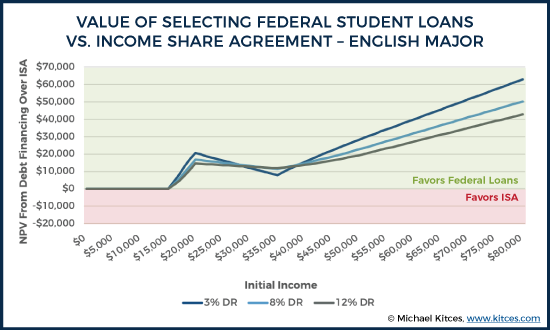
Note: This graphic illustrates the NPV of the cash flow stream generated by subtracting the Federal loan cash flows from the ISA cash flows. Therefore, if the NPV is positive, then a federal loan was the more advantageous strategy, whereas if the NPV is negative, then the ISA was the more advantageous strategy.
Notably, the results show that the Federal loans always finish equal to or ahead of the ISA (otherwise, the chart would turn negative to show the loans as inferior). However, neither strategy has an advantage for English majors at income levels of less than $16k, since under both financing options, an individual would pay nothing based on this initial income. The reason an NPV advantage in favor of the Federal loan begins to emerge at $16,000 is that, at this starting income level, the assumed rate of inflation (3%) begins to lift the individual’s earnings above the $20,000 level prior to the end of the ISA repayment period. (Note: While realistically it would seem that Purdue’s ISA would adjust the income floor with inflation over time, this is not specified in their contract, so a flat $20,000 floor is assumed in all years.)
However, the chart above only answers the “total cost” question regarding comparing the two strategies. This may not be the only factor prospective students are considering when choosing between a federal loan and an ISA. Realistically, students would also be interested in the burden each strategy would place on their eventual cash flow.
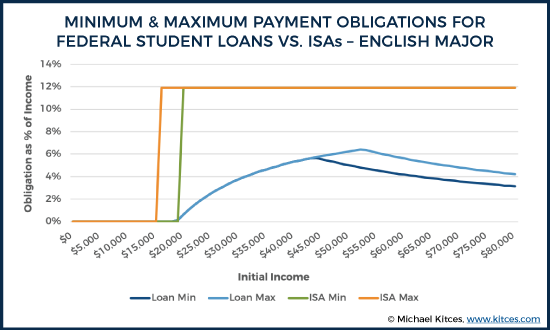
Note: In the chart above, “Min” and “Max” refer to the minimum and maximum rates an individual pays over all years of repayment. In many, but not all, scenarios, the minimum and the maximum are equivalent.
As the chart above illustrates, not only is the ISA a larger financial burden overall (as illustrated in previous NPV calculations), but it actually would be much more of a burden on an individual’s cash flow when compared to traditional student loan financing. The downsides of the $20,000 breakpoint in triggering ISA repayment versus the more gradual approach of federal loans is illustrated here as well. As soon as an individual cross the $20,000 threshold, they jump up to their full ISA burden of nearly 12% of their income, whereas the federal loan line gradually creeps upward as income grows (because it’s a percentage of income above the threshold for Federal loans, not a percentage of all income once the threshold is reached with an ISA).
The charts below examine the same considerations, but this time for our hypothetical aerospace engineer, who receives some of the most favorable ISA terms (with respect to income repayment percentages and also loan terms).
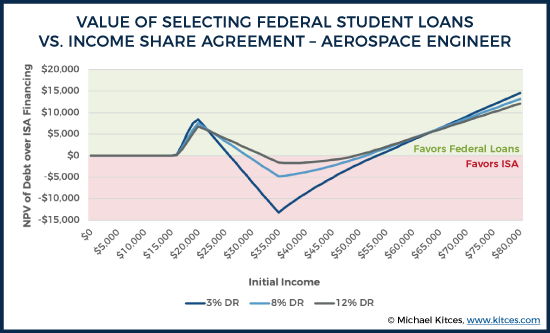
As the results reveal, as long as an aerospace engineer happens to earn near the average initial salary for their field (~$60k), they’ll come out ahead by using a Federal student loan. However, interestingly, if they earn moderately to substantially less than average (e.g., somewhere within the $26k-$53k, depending on the discount rate used), then the lower percentage payment and shorter payback period of an ISA could be to their advantage. In this case, the magnitude of difference isn’t huge (the maximum NPV difference is roughly $13,000 in favor of the ISA at a $35k of income and a 3% discount rate), but in this case there does appear to be some more plausible downside protection for someone who enters a higher-income field but unfortunately ends up in a below-average-income job.
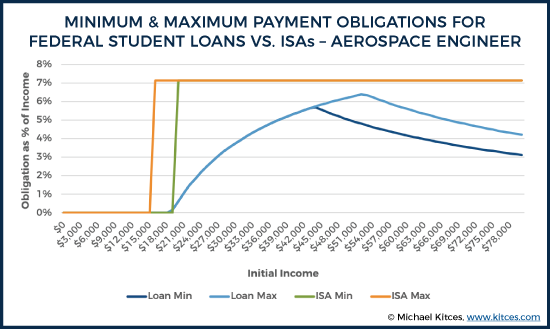
As was previously the case, though, downside protection is not all that a student may care about. There’s also the question of the overall burden on one’s cash flows. In this case, we still see the same dynamics as was previously illustrated for the English major. As soon as income crosses the $20k threshold, burdens immediately jump to the full repayment level of roughly 7%. However, because the overall percentage of income owed is much lower for an aerospace engineer when compared to an English major financing the same amount of tuition, the difference between the maximums under various scenarios is less pronounced. Nonetheless, it would be fair to say that ISAs still place a larger burden on one’s cash flows when compared to a traditional Federal loan. To the extent that the ISA ends up as the lower-cost option, it’s only because of the ISA relief in the later years (after the ISA term ends, but while the Federal student loan payments may have had to continue) and not in the early years (when the ISA still has a higher cash flow burden).
Based on the findings above (and assuming that one is comparing federal loans to an ISA that is similar in nature to the Purdue ISA), it seems safe to say that Federal loans should generally be preferred to ISAs. There may be some niche cases in which students may want to consider ISAs first (e.g., situations in which individuals know ahead of time they will not be able to achieve even the average earnings in their field of study, or perhaps in cases such as an engineer who would like to take 10 to 15 years out of the workforce to raise children). But, generally speaking, the flexible features built into Federal loans provide equal (if not superior) outcomes in terms of both overall repayment and cash flow protection.
However, Federal loans may often fall short of what a student needs to fully fund their education, and this is particularly true for students who are attending more expensive private institutions. As a result, it may be best to think of ISAs not as a replacement for traditional Federal loans, but as a replacement for their more expensive and less flexible supplemental funding sources, such as private student loans.
A Direct Comparison of ISAs vs. Private Loans
For the purposes of comparing ISAs versus private student loans, the same framework is used as above, with the exception that a private student loan, with an 8% fixed interest rate and no flexible payment provisions, replaces the federal loan.
When comparing overall financial burdens, we can see that the ISA option is no longer a clear loss for our English major across all initial income levels.
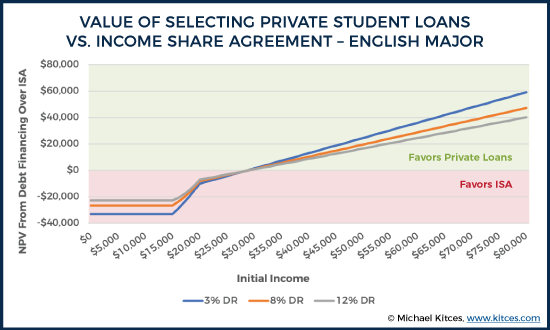
Note: The same $26,500 tuition funding level is assumed just for the sake of consistency, although this may or may not reflect a typical funding need for supplemental funds based on an individual’s circumstances.
In this case, we see that our English major is better off with an ISA if their initial income level ends up being less than roughly $30,000. The reason that this is so different is that there is no longer any potential benefit of loan forgiveness for lower-income individuals when using private student loans. At income levels below $16,000, our English major comes out roughly $23k to $33k ahead with the ISA in terms of NPV, depending on what discount rate is used. At the same time, for incomes above $30,000, our English major still quickly comes out far behind with the ISA, given how much cheaper even an 8% interest rate is when compared to the “effective” interest rate built into an ISA structure (that takes an ever-higher percentage of the ever-higher income). If our English major ends up changing fields or just securing a very high paying entry-level job for English majors of $70k, they would end up somewhere between $32k and $48k worse off in NPV terms, depending on the discount rate used.
Of course, as was the case before, NPV differences only tell part of the story.
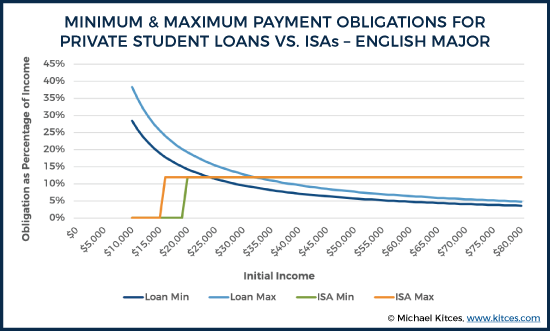
Note: Results for incomes below $10,000 were omitted for the purposes of making this chart readable.
When we examine the differences in cash flow burden between ISAs (which do have income-driven protections built in) and private loans (which do not have income-driven protections), we can quickly see that ISAs do provide some real relief in terms of potential cash flow burdens, at least at lower income levels. At incomes below $20k, the English major pays nothing towards their ISA, whereas private loan burdens could claim 30% or more of one’s cash flow. Even despite the relatively high 12%-of-income burden that the English major occurs immediately at $20k in income, it isn’t until reaching initial income levels of roughly $30k that a private loan burden would reach levels roughly as “low.” Of course, beyond the roughly $30k income level, the overall cash flow burden of private loans is substantially lower than paying a percentage of income (on ever-higher income levels), and the burden of private loans continues to decline as income increases.
(Note: One factor not captured here is the potential taxation of ISA funds. As discussed in the ISA overview above, how ISAs are eventually treated from a tax perspective, if/when forgiveness ultimately comes into play, would be a significant factor worth considering.)
We see similar dynamics for our aerospace engineer.
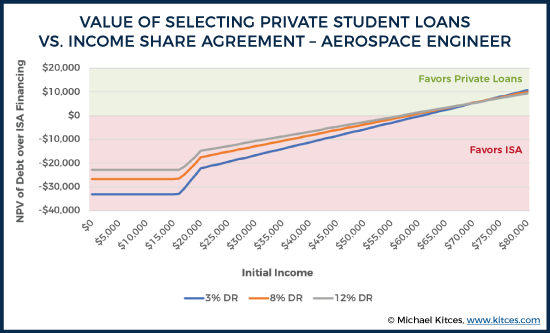
At lower income levels, our engineer comes out ahead with the ISA, thanks largely to its percentage-of-income cap and its relief for those with less than $20,000 of income. Although in this case, the engineer actually comes out ahead with an ISA up until income levels of roughly $60k.
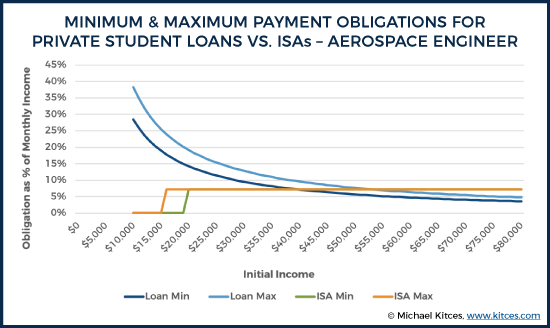
From a cash flow perspective, little difference exists between the English major and the engineer, with the exception of the lower ISA cash flow burden for the engineer. But that lower percentage leads to an even higher income crossover before the ISA for the engineer is worse than taking out traditional private loans. The crossover point for maximum cash flow obligations occurs at roughly $54,000 in income, and the difference between either strategy is less pronounced over much of the potential income spectrum.
When Is An ISA Best To Finance College Tuition?
As the results make clear, using an ISA is virtually never superior to Federal student loans, for those who can take advantage of such loans in the first place. In practice, the income protections of Federal student loans programs – through various income-driven repayment plan options – provide more generous protection than ISAs for those who don’t end up with strong earnings after college. And the ISA is simply more expensive for those who do end out with superior earnings after college, given the percentage-of-income formula of ISAs in the first place.
By contrast, the decision of whether to use an ISA in lieu of a private loan is less clear than the Federal loan comparison. On the one hand, there are very real potential reductions in one’s total repayment obligation and cash flow burden should they end up unemployed or underemployed when using an ISA. However, should an individual come out at or above average in income, there’s also a substantial cost associated with such agreements (at least as considered here) compared to “just” borrowing with private loans and repaying them later.
The decision, then, is not unlike any other risk/reward tradeoffs that we must consider. All else being equal, the more risk-averse one is, the more attractive ISAs are going to look in lieu of private loans, as ISAs are a means to reduce the downside risk (of low income) by trading off some upside potential (more payments for the ISA if income does end out being above-average after college).
The one clear case we can make for using ISAs is to use an ISA when one can engage in adverse selection (for the ISA lender), effectively "gaming the system" with their own knowledge of their current and future plans. Specifically, at least with respect to the Purdue agreement, the clearest ISA scenario seems to be someone who is going to college but has a plan or strong desire to be a stay-at-home parent thereafter. This is private knowledge that an individual has about their own preferences, which counterparties in an ISA will never be privy to. Of course, this type of adverse selection also threatens the viability of ISAs overall, and we’ve yet to see any examples of ISAs that have managed this adverse selection problem and been successful over a long time horizon. Nonetheless, whether ISAs are viable in the long run doesn’t make any difference for someone who has access to funding via such means today, and those who know they wish to stay at home as a parent in the future may be able to grab some college funding they’ll never need to repay.
Students may also wish to consider what their own attributes suggest about what their personal ROI from attending college may be. As Bryan Caplan highlights in his book, The Case Against Education, college ROIs vary substantially by student quality. Caplan separates students into quality categories as follows: excellent (a student with the typical traits of an individual who completes a master’s degree), good (a student with traits typical of an individual who completes a bachelor’s degree), fair (a student with traits typical of an individual who completes high school), and poor (a student with traits typical of an individual who does not complete high school). “Traits” in this case could largely be boiled down to intelligence (e.g., IQ) and work ethic (e.g., conscientiousness). Caplan estimates that an excellent student would be at roughly the 82nd percentile of cognitive ability, whereas a poor-quality student would be about the 24th percentile.
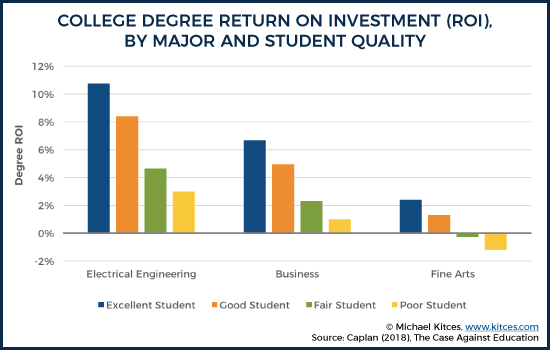
As Caplan explains, ROI in this context refers to:
Zero and negative returns don’t mean fine arts degrees are worthless in the labor market. A fine art degree raises expected income by over 20%. What zero and negative returns mean, rather, is that capturing that raise is more trouble for Fair and Poor Students than it’s worth.
This can be a hard topic to be honest about, but the reality is that student quality is going to influence how realistic it is for a given individual to achieve “average” outcomes for an individual majoring in their discipline at a particular school. Individuals who are “above average” relative to their peers (which is different than above average relative to the population, as all physics majors at Harvard are likely well above “average” at the population level, but, by definition, half of them are below average relative to their peers) are more likely to experience better financial outcomes. As a result, all else being equal, higher quality students should be more inclined to pursue traditional debt financing, rather than give up a future percentage of their likely-to-be-above-average income with an ISA. Of course, ISAs could also start pricing based on GPA, ACT/SAT, etc., which may reduce the potential returns to adverse selection on this dimension.
Students with nontraditional career options may also want to give ISAs particular consideration. For instance, a student who plans to join a family real estate business after graduation may be able to structure their compensation in a manner that is advantageous for the purposes of reporting income (or rather, not reporting income as earned income) within the terms of an ISA (e.g., by participating in the real estate income as rental income via Schedule E, which isn’t part of the ISA income calculation).
Another consideration that will increasingly come up is the discrepancies between costs by major. Generally freshman and those who have not declared a major are excluded from ISA programs (presumably due to high rates of dropping out of certain majors, such as engineering, among incoming freshman), and it’s not clear how all programs will choose to handle situations such as dual majors (no guidelines appear to be listed on Purdue’s website, but a call to Purdue’s financial aid office suggested that applicants can choose which of their majors they wish to use when applying for Purdue’s ISA).
So long as one can successfully pull it off, dual majoring in, say, psychology (0.45% share per $1k over 116 months) and applied statistics (0.30% share per $1k over 96 months) could be worthwhile for a student who can then get ISA funding based on statistics even though their true interest (and future career aspiration) is psychology. (Notably, it’s also not clear what would happen if a student was an applied statistics major at the time of applying but abandoned that second major prior to graduation.) Of course, this is again a problem that programs will need to address, via pricing or otherwise, in order to remain viable long-term, but it’s nonetheless an opportunity for students who do wish to pursue an ISA to potentially secure better terms for themselves.
As should always be the case, the fine print on these Income Share Agreements is tremendously important as well. As more universities and private ISA providers roll out their own programs, individuals will need to pay careful attention to the actual agreement they are signing, and the specific terms of that agreement.
Ultimately, it is still too early to say what type of influence ISAs will have on college funding in the long run. However, they seem to have captured a lot of public interest, and many people seem to intuitively feel that ISAs have better characteristics when compared to traditional debt financing. But this is less clear when we actually dig into the details of such agreements. Compared to Federal loans, there’s probably little reason to pursue ISAs, unless one has some personal knowledge that allows for significant adverse selection against the ISA funder (and in favor of themselves, based on the exact ISA rules). Compared to private loans, though, there is some very real downside protection for ISAs in terms of total repayment obligation and cash flow protection, but this comes at a fairly significant long-term cost so long as one achieves at least “average” (or higher) income outcomes in the long run after college.





Thanks for a great analysis Derek.
However, I think that it misses some key points. I think its expected that all things being equal, a graduate who ends up with a decent salary will end up paying less on a traditional loan than on an ISA. The fact that there is less downside risk on the ISA implies that you pay a premium on that reduced risk.
Proving that ISAs cost more (in typical cases) does not undermine the ISA case.
The following arguments in favor of ISAs have to be factored into the equation when making a comparison:
– You only begin repaying after you graduate and get a job. This provides breathing room and peace of mind. You have less need to get a demanding job while you study. You can focus on your studies.
– There is peace of mind in that you only pay if you graduate and find a good job. This value might be hard to calculate, but its not insignificant. You mention that risk appetite plays a role in determining if ISAs are suited for a particular candidate, but I don’t think you give this benefit sufficient emphasis, its central to the ISA argument.
– The ISA provider will, in many instances, play an active role in supporting your career (because they have a stake in it), helping to maximise your earnings, so that on average the student who takes an ISA might end up earning more than the student who takes a loan. Think how important it is for Pardue to partner with employers and to ensure that its curriculum is aligned with the needs of the employment market,
(note: my points are phrased as declarations but are intended in the spirit of questions or points of discussions)
Yoni, no disagreement with the points you raised here. Regarding the first two points, I would only note that this is largely true of federal loans as well, so the ISA really only becomes an attractive consideration once federal loans have been exhausted. That point is acknowledged by the Purdue ISA (and others), but I do think there are many people who don’t realize those features are effectively embedded within federal loans today.
I think your third point is an interesting value proposition that ISAs can put forward. If they can deliver on that, then certainly they become more attractive. Of course, you could also end up with a situation where people could then take out the minimum needed to gain access to ISA support while retaining as much upside as possible. If ISAs become widespread, then that value proposition also becomes harder to deliver on, but it is a potential benefit for students to think about (and perhaps more so while ISAs are not widespread and benefits might be concentrated on a smaller number of students).
Derek,
Nice analysis. It seems to me that factoring in scenarios for tax treatment of ISAs has the potential to either narrow the performance gap or dramatically increase it. There are currently two versions of bills that have been introduced to regulate ISAs at the federal level, H.R.3145 and S. 268 – both proposed in 2017. The house bill has been referred to committees. Each bill has very similar language around tax treatment. Importantly, it proposes that any shortfall of repayment relative to the initial funding amount would not be attributed to the student as income. As could be expected, the distributions themselves are a non-taxable event to the student. Unfortunately, there is no specific language regarding whether (and in what way) the income share installment payments would be tax deductible for the student. The legislation treats the agreement as a contract whereby installments of shared income would initially serve to reduce the basis and then any additional shares of income would be taxed as gross income to the contract holder. Given the symmetry of the tax code (ideally), one could assume that the shares of income over and above the basis would be tax-deductible for the student.
Hopefully, these would be above the line deductions like current treatment of student loan interest. A requirement to itemize these payments would be catastrophic since the itemization of a recently-graduated, low-earning taxpayer’s deductions would almost certainly not eclipse the standard deduction, thereby removing all tax efficiency. This would harm the very segment of the population this type of loan is ostensibly created to help. Assuming the student could take payments as an above the line deduction (seems as though there would have to be some kind of strange 1040 contra-revenue account to keep track of what is return of capital and what is dividend) this could alter the effective performance of the ISA. Interestingly, it would operate the reverse of the student loan interest deduction. As time goes by, the tax deduction resulting from the income share would grow proportionately with income and apparently equate to 100% of the income share, if we are to follow the logic of the proposed legislation. This is of course unlike the student loan where the tax benefit shrinks as you move along toward maturity of the note. Given your analysis, I tend to think federal student loans would still outperform ISAs. However, factoring in the timing and magnitude of tax benefit might at least make a race of it – especially if ISA payments were not subject to the same $2,500 interest cap.
Very interesting. I was not aware of the bills introduced to regulate ISAs. It sounds like that proposal would narrow the gap. Thanks for sharing!
If I’m looking for very nuanced educational info on a complex financial planning topic, nobody even comes close to Kitces.
Thank you, Micheal. You’ve contributed so much to my growth as a financial planner and, in turn, you’ve helped dozens (or hundreds) of clients achieve their dreams. You should be proud of your work, it’s changing the world. At least, it is for one advisor.
Happy to be of service! 🙂
– Michael
Very interesting article! While ISA’s seem to be getting a lot of attention, I can’t help but think it’s due in part to the fact that so many people simply don’t understand all of their options with federal student loans. There are up to 8 different types of repayment plans for federal student loans and depending on an individuals circumstances the best option for them can often change throughout the years. A couple of observations and points to consider along with your article:
1. Unpaid interest on federal student loans (due to negative amortization) is not always added to the principle balance of the loan. Under many of the income driven plans, unpaid interest on subsidized loans is waived for the first 3 years! Under the Revised Pay as You Earn Plan, half of unpaid interest on ALL loan types is waived and then all interest on subsidized loans for the first 3 years.
2. Unpaid interest is ONLY capitalized into the loan balance (for purposes of calculating interest the following year) when the borrower can no longer display a “partial financial hardship”.
3. A Spouse’s income is not always included for an income driven repayment plan. Under all income driven plans (except Revised Pay as You Earn) the couple could file their taxes as married filing separately and then for purposes of calculating income on their plan, ONLY the spouse with student loans income is counted. For couples where you have a high earning spouse who doesn’t have student loans, the benefits of choosing to file separately can often outweigh the tax deductions they would have received from filing jointly.
4. The Income Driven Repayment plans often allow alternative documentation for verifying income beyond just your most recent tax return. In many cases a recent paystub or verification letter from an employer can be used which helps to get around other sources of income that can be on a typical tax return.
All in all, it’s important that each individual weight the pros and cons of their specific situation and reach out to a professional for assistance should they require it. ([email protected])
Thanks for sharing! This is certainly an area where it is important to look at the specifics of an individual’s situation.